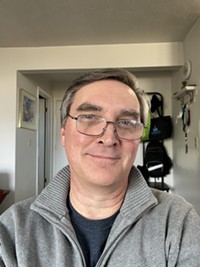Utah Arts Festival 2025 Preview
The annual arts showcase emerges from a challenging year with feedback for new ideas.
By Scott Renshaw @scottrenshawIn August 2024, Utah Arts Festival executive director Aimee Dunsmore faced a situation no non-profit leader wants to face. After disappointing attendance at the 2024 festival resulted in a significant budget shortfall, UAF needed to figure out how to pay its bills. So Dunsmore did the only thing that made sense to her: She was honest.
In a press release, UAF laid out their situation in clear terms. "For all intents and purposes, the programming was great: well-received on site, very good energy," Dunsmore said. "The issue was that we didn't have enough people attend. ... So it was a little disheartening, but we knew, in order to move forward, we needed to be transparent and tell the community where we were, and ask for help. ... If we act embarrassed and keep this to ourselves, how will that serve us? It did feel like a risk, but it also felt to me like a better risk to be more honest and transparent about it than to act like everything's fine, then still be in a difficult situation the next year."
"That was probably one of the scarier things I've done in my career," she added, "because the answer could have been, 'Hey, you are where you are, we don't really need this event, we're not that interested.' And luckily, that was not the result that we saw."
After an outpouring of public support and generosity from vendors, UAF was able to resolve its short-term financial troubles. Perhaps just as important, however, feedback received from that August 2024 press release provided a framework for changes that could improve attendance in the long term.
Among the most significant pieces of feedback was one that might seem difficult to address for an event that takes place in late June: It gets hot. "If I could order specific weather, I definitely would," Dunsmore says; "any event director would." But absent magical weather-control powers, there were still adjustments that could be made to festival layout that could allow for a more enjoyable experience, regardless of the temperature.
One key adjustment involved a decision that was also financial: not making use of the Amphitheater Stage. Shifting performances to other stages resulted in a ripple effect that allowed for optimizing the use of shadier locations. For example, Dunsmore noted, "We wanted to make Urban Arts more central—which then, why the Park Stage over there all by itself? Which got us moving to more of the West Side of the City & County Building [with] more shade, less pavers, more grass. So it was a little bit of a domino effect on some of those decisions."
Dunsmore and UAF also decided to bring back Thursday after reducing to three days for a few years. That might seem like a counter-intuitive choice in a time of belt-tightening, yet it was another example of listening to public feedback. "We were hearing a lot from the public survey and from our artists that 'we want Thursday back,'" Dunsmore said. "So then it was, should we do Thursday and Friday just in the evening; Friday we do have attendance during the day, Thursday's a little harder. So we thought, let's keep Friday, do a heavy discount from noon to 3, we still want those people to come in, and do Thursday. And Thursday has been, online so far, our best-selling ticket."
Accompanying that return to Thursday hours is a return to free youth admission, part of an emphasis on making the event as accessible as possible, including that discounted Thursday and early Friday admission. "We looked at the numbers and thought, we want people to access the arts, and we're not making enough money on that to make it worth continuing to try to charge kids," Dunsmore said. "It's a value we hold, that the more people we can have get involved, especially young, [the better], and that [requires being] affordable for families. The benefit of bringing that back, compared to any financial loss? It was a drop in the bucket."
This year also marks an expansion in the idea of having some artists not just selling their work, but demonstrating how they create it on-site. Along with shaking things up with a diverse range of performances on any given stage, it's an attempt to continue a mission of exposing people to the whole artistic spectrum. And after a difficult year, Dunsmore sees fulfilling that mission as a payoff for the challenges.
"This is a labor of love, not just for us, but for the coordinators, for the volunteers, for the captains and crews," she remarked. "That's what keeps me going. And this has probably been, personally, one of the hardest years of my career, to try to work these things out. I just feel like this is something the community wants and needs. There's a lot going on in our community and in the world, and this is a place to come and celebrate, to have a little respite from that."
More by Scott Renshaw
-
Film Reviews: New Releases for July 18
Eddington, Smurfs, I Know What You Did Last Summer, Don't Let's Go to the Dogs Tonight
- Jul 17, 2025
-
July Weekend Festivals Roundup
Ogden Arts Festival, Draper Days, Utah County Lantern Festival, American Fork Steel Days and more.
- Jul 16, 2025
-
Movie reviews: Eddington, Don't Let's Go to the Dogs Tonight, Smurfs
Three new movies in theaters for July 2025.
- Jul 16, 2025
- More »




